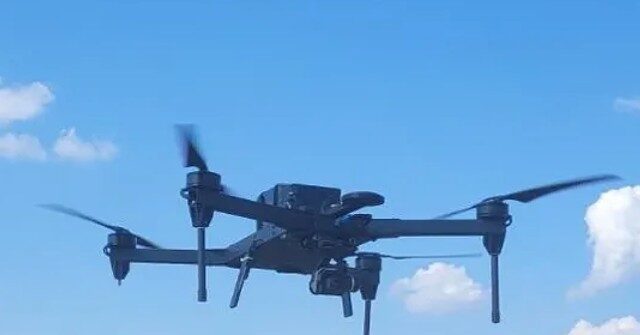Top News
Report: Ukraine Is Using Autonomous AI ‘Killer Drones’

New Scientist on Friday claimed that Ukrainian attack drones guided by artificial intelligence (AI) “are now finding and attacking targets without human assistance.”
The report appears to be history’s first example of fully autonomous weapons, and, if those vehicles were occupied, the first Lethal Autonomous Weapon Systems (LAWS) or “killer robots.”
The drone in question is allegedly a new quadcopter model called the Saker Scout, an indigenously produced unmanned aerial vehicle (UAV) that can be folded up and lugged around in a suitcase-sized container.
Saker is a young Ukrainian company founded in 2021 to produce commercial AI and drone solutions. The company decided to develop a military product after Russia invaded in February 2022.
“Your support will help us make a ‘bird’ and deliver it on your behalf to the defenders of Ukraine!” the company said in its pitch to investors, making a little pun on its corporate name and purpose, as the Saker falcon is a hunting bird found in the steppes of Ukraine.
Developed with remarkable speed and initially deployed in September 2023, the Saker Scout claims to be a tough, barebones-looking UAV with a prominent camera assembly hanging from its belly and an explosive charge strapped to its back. The Saker platform is distinguished, creators say, by its AI control system. The drones operate as an autonomous network in flight, hunting down camouflaged enemy vehicles with recon units and then sending in bomb-laden drones to make the kill.
Defense Express noted when the Saker Scout was unveiled in September that its advanced artificial intelligence was not cheap or easy to produce, but the drones themselves cost a relative pittance. Swarms of drones working together to find and eliminate targets without human intervention are very cost-effective compared to traditional infrared or radar-homing missiles. Taking human operators out of the equation makes the Saker airborne network very difficult to jam.
New Scientist noted that Saker Scouts can be piloted by human operators in the traditional manner, with the AI picking out 64 different types of Russian “military objects” and inviting the operator to commit bomb drones to attack them. Input from the drone groups is collated into Delta, the Ukrainian situational awareness computer system. Delta is a supercomputer that creates highly detailed real-time battlefield maps by collating input from various sensors and devices.
According to a Saker representative who spoke with New Scientist, the company’s drones have now been deployed in autonomous mode “on a small scale,” with human operators taken out of the loop.
Military analysts greeted the long-anticipated arrival of killer robots with trepidation. Humanitarian groups worry that autonomous systems might be less scrupulous about avoiding civilian casualties, as they could act with lethal force against “false positive” targets without human oversight. Military experts fear the coming of autonomous weapons that might escalate a conflict very rapidly, leaving their human masters behind as they duel with each other at lightning speed.
The Saker spokesperson told New Scientist that “using the drone in autonomous mode is less reliable than having a human in the loop,” but the system has proven effective so far, and the Ukrainian military believes it is “more important to deploy a weapon that worked now, rather than waiting until it was perfect.”
“Ultimately, Ukraine will need large numbers of drones that can operate autonomously, locating and striking targets at machine speed,” the spokesperson said.
Foreign Policy (FP) noted in May there have been rumors of autonomous weapons before, stretching back to the deployment of Turkish Kargu-2 drones in Libya in 2020. Turkey’s wildly popular Bayraktar TB2 drones, which Ukraine used to great effect against Russia in the early days of the invasion, reputedly have limited autonomous capability. Russia claims to have deployed its own AI-controlled strike drones to Ukraine.
Unless some of those earlier suppositions and rumors are confirmed, the Ukrainians and their Saker drones will take the prize for using the first fully AI-controlled weapons platform in battle and possibly for causing the first AI-directed fatalities.
United Nations Secretary-General Antonio Guterres went further than many other skeptics in 2019 when he said autonomous weapons were “politically unacceptable, morally repugnant, and should be prohibited by international law.”
Among the issues Guterres referred to was the danger that autonomous weapons could be programmed to “target individuals or groups that fit certain descriptions” and the possibility that nation-states or rogue actors could launch LAWS attacks without revealing their identities. This would make AI weapons ideally suited for hate crimes, ethnic cleansing campaigns, political assassinations, and authoritarian regimes looking for a quick and deniable way to wipe out dissidents.
FP warned:
Once these technologies have spread widely, they will be difficult to control. The world thus urgently needs a new approach to LAWS. So far, the international community has done nothing more than agree that the issue needs to be discussed. But what it really needs to do is take a page from the nuclear playbook and establish a nonproliferation regime for LAWS.
The imminent problem is that the Ukrainians can make a very good case for why they need LAWS to turn the tables against the Russian invaders, and if the systems prove effective, Kyiv is unlikely to heed lectures about why it should not be using them.
Read the full article here


















